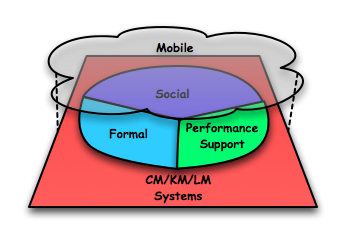Why is the world getting more complex? Certainly, we’re getting more information, and technology is increasing the rate at which we can sense, and respond (reducing product cycle times, for instance, as someone can replicate what you’ve developed very quickly). There’s a lot more pressure, as a consequence. But is it something fundamental?
I was pondering Dave Snowden’s Cynefin framework (wonderful 4 minute video explaining it), particularly the chaotic domain and it’s prescription (roughly “do something, and hope to move it to one of the other quadrants”). It’s kind of a deep concept, but basically there are: simple topics where there’s one right answer (which we ought to automate, in my opinion); complicated issues, where we need expertise; complex issues, which we can only explain in retrospect but can adapt in, and the chaotic space.
It’s the latter that concerns me, it seems to be a case of “abandon hope, all ye who enter here”. Ok, seriously, it’s a place where the approach has to be much more experimental. I reckon it’s a place that most managers and even executives want to ignore. And yet, I believe that the world is going more and more in that direction. In fact, I’m beginning to believe we’re at a inflection point where we suddenly need to realize that ‘management’ just won’t cut it. Sure, for legacy industries, for a while. But why? Why is this fundamentally different?
I think that things moved slow moved enough that while they really were chaotic, the general patterns were good enough most of the time. But things have increasingly gotten faster, accelerating, to the point where those seemingly random shifts are happening so fast that they undermine staid process.
It’s not the information overload, and I began thinking that it is, instead, how quickly ideas can take hold. It’s not things that are the dominant factor here, it’s people. People’s reactions to marketing campaigns, messages, etc are largely unpredictable, and the likelihood and consequences of something going ‘awry’ are increased. The so-called ‘viral’ message is increasingly a disruptive factor. And why is that?
I started thinking about how long it took for ideas to spread. In the past, they could spread in a community by word of mouth over hours or days, depending on the ‘salience’ of the idea. However, a community was sort of 150 people, if you take a Dunbar’s number approach. Propagating outside of that was a critical juncture, and used to be quite hard. Someone had to travel between communities, believe, and be a good transmitter. Print as a major shift, and so too was the printing press. Suddenly it became easier to transmit a powerful meme powerfully. And it’s gotten easier with the telegraph, and the phone, and email, and…
If new ideas that are powerful can take hold quickly with minimal friction, their disruptive influence is magnified. Rightly or wrongly, a fun or powerful idea can catch fire and be a game-changer. If there’s the possibility for almost instantaneous spread, we’re truly past the point of no return in terms of chaos.
Which brings me to Twitter. Even the latest web page had to be emailed and there wasn’t a quick way to get the message around in a broadcast style except if the mainstream media picked it up, or you had an established network. Spreading beyond your network was difficult.
Enter Twitter. For the first time, a viral meme can spread almost instantaneously, reaching critical mass in the amount of time required for a few retweets. It’s a network of one to many, and 140 chars is about perfect for ‘meme’ length. It’s just a twitch to pass a message on. I’m not saying Twitter itself is the force of change, I’m saying it’s emblematic of the change.
If someone’s thought captures a new thought, or plays with an existing idea in an intriguing new way, it can spread almost instantaneously. Much more so than before. That’s a power that can be used for good or bad. Companies should be mindful that a misstep can reach many really quickly (time to get on the ClueTrain!). And breaking news can spread before the media reach the masses (cf flight 1549 landing in the Hudson).
I doubt this idea is new, and you’re free to point out where I’m wrong or who said it before, but it struck me that this is indicative of the changes we, our communities, our organizations, and our society face. Which leads me to think it’s time to take this phenomena seriously. So I’ll venture a meme, an oldie but a goodie, “World Peace, NOW!”. Here’s hoping…
 So I’ve been playing with rethinking my Performance Ecosystem conceptualization and visualization. The original had very discrete components, and an almost linear path, and that doesn’t quite convey the reality of how things are tied together. I believe it’s useful to help people see the components, but it doesn’t capture the goal of an integrated system.
So I’ve been playing with rethinking my Performance Ecosystem conceptualization and visualization. The original had very discrete components, and an almost linear path, and that doesn’t quite convey the reality of how things are tied together. I believe it’s useful to help people see the components, but it doesn’t capture the goal of an integrated system. So here’s my current conception. It took me a long time to create the circle with different components! First I had to discover that there were tools to create freeform shapes, and then work to get them to articulate, but I like the kind of ‘rough’ feel of it (appropriate for it’s stage).
So here’s my current conception. It took me a long time to create the circle with different components! First I had to discover that there were tools to create freeform shapes, and then work to get them to articulate, but I like the kind of ‘rough’ feel of it (appropriate for it’s stage).